Leukocytes Study guides, Class notes & Summaries
Looking for the best study guides, study notes and summaries about Leukocytes? On this page you'll find 6631 study documents about Leukocytes.
Page 3 out of 6.631 results
Sort by

-
Straighterline Anatomy and Physiology 2 BIO202 Cumulative Midterm 2023
- Exam (elaborations) • 18 pages • 2023
- Available in package deal
-
- $7.99
- 1x sold
- + learn more
Straighterline Anatomy and Physiology 2 BIO202 Cumulative Midterm 2023 Hello We are a team of experts offering course attendance for all Straighterline, Portage Learning, Sophia etc courses. We also write essays, research papers and school assignments. Should you need any of these services, Contact us via email: or : +1 (908) 954-4829. Guaranteed Passing! BIO202_MH_V3 Topic 7: Digestive System Started on Saturday, June 10, 2023, 2:26 PM State Finished Completed on Saturday, J...

-
D027 Exam Questions & Answers Latest Updated 2023
- Exam (elaborations) • 19 pages • 2023
- Available in package deal
-
- $18.49
- 2x sold
- + learn more
D027 Exam Questions & Answers Latest Updated 2023. As an advanced practice nurse, you want to learn more about the CDC’s initiatives relative to asthma care and management in order to advocate for asthma sufferers at the state legislative level. Your goal is to reduce medications costs to patients. Which CDC recommendation supports your goal? (0/1 Point) The CDC recommends that payers and employers promote healthy workspaces to decrease environmental trigger exposures. The CDC recommends...
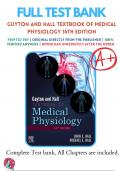
-
Test Banks For Guyton and Hall Textbook of Medical Physiology 14th Edition by John E. Hall; Michael E. Hall, 9780323597128, Chapter 1-86 Complete Guide
- Exam (elaborations) • 262 pages • 2023
-
- $28.40
- 2x sold
- + learn more
Guyton and Hall Textbook of Medical Physiology 14th Edition 7128 0039 6, 8, 0, 0039, 8390, 0060 1. Functional Organization of the Human Body and Control of the “Internal Environment” 2. The Cell and Its Functions 3. Genetic Control of Protein Synthesis, Cell Function, and Cell Reproduction 4. Transport of Substances Through Cell Membranes 5. Membrane Potentials and Action Potentials 6. Contraction of Skeletal Muscle 7. Excitation of Skeletal Muscle: Neuromuscula...
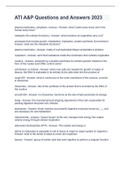
-
ATI A&P Questions and Answers 2023
- Exam (elaborations) • 25 pages • 2023
-
Available in package deal
-
- $10.49
- 2x sold
- + learn more
plasma membrane, cytoplasm, nucleus - Answer- what 3 parts does every cell in the human body have? metabolic life (cellular functions) - Answer- what functions do organelles carry out? processes that include growth, metabolism, replication, protein synthesis, & movement - Answer- what are the metabolic functions? plasma membrane - Answer- made of a phospholipid bilayer embedded w proteins cytoplasm - Answer- semi fluid substance inside the membrane that contains organelles nucleus...
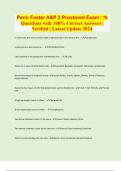
-
Penn Foster A&P 2 Proctored Exam | 70 Questions with 100% Correct Answers | Verified | Latest Update 2024
- Exam (elaborations) • 6 pages • 2024
-
- $7.99
- 1x sold
- + learn more
In mammals, the most common type of agranulocyte in the body is the... - Lymphocyte Leukocytes are also known as... - White Blood Cells Cells involved in the production of antibodies are... - B Cells Name the 5 types of white blood cells - Neutrophil, Basophil, Eosinophil, Monocyte, Lymphocyte Name three types of lymphoid tissue - Lymph Nodes, Tonsils, Spleen, Thymus, Bursa of Fabricius, Peyers Patches Name the four types of cells that lymphocytes can be divided into - B cell, T Cell, NK C...
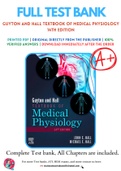
-
Test Bank for Guyton and Hall Textbook of Medical Physiology 14th Edition By John E. Hall; Michael E. Hall Chapter 1- 85 Complete Guide A+
- Exam (elaborations) • 266 pages • 2023
-
- $29.08
- 3x sold
- + learn more
Test Bank for Guyton and Hall Textbook of Medical Physiology 14th Edition By John E. Hall; Michael E. Hall Chapter 1- 85 Complete Guide A+ 7128, 2 1. Functional Organization of the Human Body and Control of the “Internal Environment” 2. The Cell and Its Functions 3. Genetic Control of Protein Synthesis, Cell Function, and Cell Reproduction 4. Transport of Substances Through Cell Membranes 5. Membrane Potentials and Action Potentials 6. Contraction of Skeletal Muscle 7...
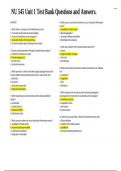
-
NU 545 Unit 1 Test Bank Questions and Answers.
- Exam (elaborations) • 20 pages • 2023
- Available in package deal
-
- $12.99
- 1x sold
- + learn more
NU 545 Unit 1 Test Bank Questions and Answers. CHAPTER 7 1. Which action is a purpose of the inflammatory process? a. To provide specific responses toward antigens b. To lyse cell membranes of microorganisms c. To prevent infection of the injured tissue d. To create immunity against subsequent tissue injury 2. How do surfactant proteins A through D provide innate resistance? a. Initiate the complement cascade. b. Promote phagocytosis. c. Secrete mucus. d. Synthesize lysosomes. 3. Whi...
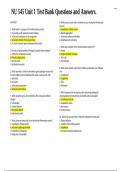
-
NU 545 Unit 1 Test Bank Questions and Answers.
- Exam (elaborations) • 20 pages • 2023
- Available in package deal
-
- $12.99
- 1x sold
- + learn more
NU 545 Unit 1 Test Bank Questions and Answers. CHAPTER 7 1. Which action is a purpose of the inflammatory process? a. To provide specific responses toward antigens b. To lyse cell membranes of microorganisms c. To prevent infection of the injured tissue d. To create immunity against subsequent tissue injury 2. How do surfactant proteins A through D provide innate resistance? a. Initiate the complement cascade. b. Promote phagocytosis. c. Secrete mucus. d. Synthesize lysosomes. 3. Whi...
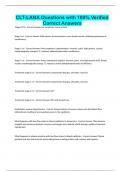
-
CLT-LANA Questions with 100% Verified Correct Answers
- Exam (elaborations) • 5 pages • 2023
-
- $11.99
- 1x sold
- + learn more
CLT-LANA Questions with 100% Verified Correct Answers Stage 0 CVI - Correct Answer No symptoms, norm protein Stage I cvi - Correct Answer Mild edema, normal protein, norm lymph vessels, phlebolymphodynamic insufficiency Stage 2 cvi - Correct Answer Mod symptoms ( pigmentation, viscosity, pain), high protein, vessels morphologically changed, TC reduced, phlebolymphostatic insufficiency Stage 3 cvi - Correct Answer Severe symptoms( hypoxia, necrosis, pain), very high protein load, lymph...
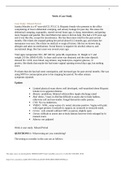
-
NRNP 6552 Week 4 Case Study Discussion Common Gynecologic Conditions, Part 1 – Missing Period
- Other • 5 pages • 2022
-
Available in package deal
-
- $13.49
- 4x sold
- + learn more
1Week 4 Case StudyCase Study: Missed PeriodJuanita Morales is a 47-year-old G5. P5 LC 6, Hispanic female who presents to the officecomplaining of lower abdominal cramping, and urinary leakage for past day. She states theabdominal cramping, suprapubic, started several hours ago, is sharp, intermittent, and gettingmore frequent and painful. She tried Motrin but states it did not help. She had a UTI years agoand it was like this, except the incontinence. She has been more tired for the past several...

Do you wonder why so many students wear nice clothes, have money to spare and enjoy tons of free time? Well, they sell on Stuvia! Imagine your study notes being downloaded a dozen times for $15 each. Every. Single. Day. Discover all about earning on Stuvia


